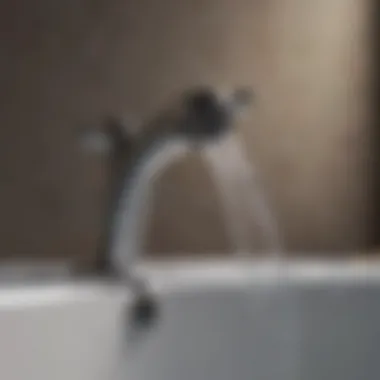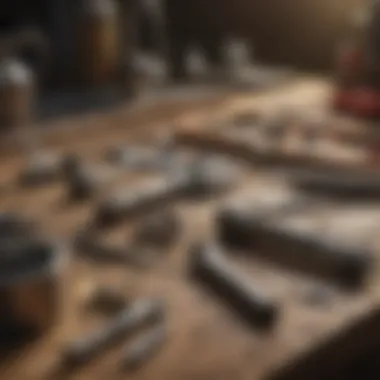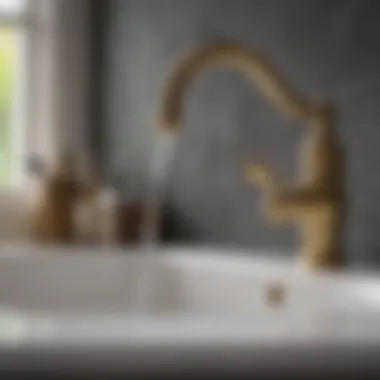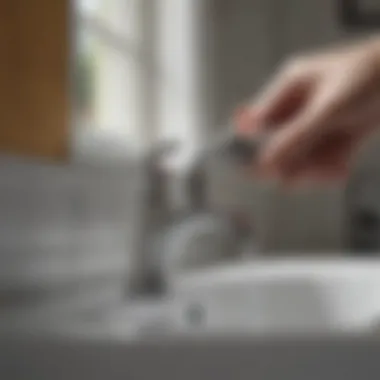Effective Solutions for Stopping a Leaking Faucet


Intro
A dripping faucet may seem like a minor nuisance, but it can lead to compounding issues over time. Not only does it waste water, but it can also lead to bigger problems like mold growth or structural damage if left unaddressed. This guide aims to help homeowners and anyone dealing with dripping fixtures in the bathroom navigate through the repair process efficiently.
Understanding the fundamentals behind faucet leaks is crucial. Often, they stem from worn-out washers, loose parts, or even issues with the faucet’s internal components. By diving into this topic, we’ll look beyond just fixing the drip—this article equips you with the know-how to tackle this common household issue, ultimately saving both water and money.
Various approaches will be laid out in this guide:
- Identifying common culprits behind faucet leaks.
- Tools you’ll need to get the job done.
- Step-by-step instructions for repairs.
- Tips on maintaining your bathroom fixtures to prevent future issues.
Arming yourself with this knowledge will not only enhance your DIY skills but also contribute to maintaining a more efficient home environment.
Intro to Faucet Leaks
A leaky faucet in the bathroom might seem like a minor annoyance, but its implications stretch far beyond just a few annoying drips. For many homeowners, what may initially appear as a simple fix can escalate into a costly headache if left unattended. The importance of addressing faucet leaks cannot be overstated. Not only do they lead to increased water bills, but they can also contribute to significant water wastage. With rising concerns about water conservation, stopping a leak becomes an essential task.
Understanding Faucet Mechanics
Faucets, at their core, are intricate assemblies of various components working together. To tackle a leak effectively, it's vital to familiarize oneself with how these mechanisms operate. Most common faucet types include compression faucets, cartridge faucets, ball faucets, and disc faucets. Each type has its design and operational quirks, but at the heart of them all is a handle that controls water flow, guided by seals and washers that maintain tightness.
You see, the smooth operation of your faucet hinges on seals. When these seals wear out or become damaged, that’s the first crack in the armor, leading to potential leaks.
- Compression Faucets: Utilize rubber washers to create a seal. These are typically found in older homes.
- Cartridge Faucets: Employ a cartridge to control flow and temperature, and often prevent leaks through durable rubber or plastic seals.
- Ball Faucets: Feature a hollowed ball that moves and creates flow; the design helps avoid leaks but requires precise alignment.
- Disc Faucets: Use a pair of ceramic discs which slide over one another to control the flow, offering a sleek and modern look.
By understanding how your specific faucet functions, you empower yourself to diagnose issues more efficiently. Knowing which mechanism is at play can save time and effort, both of which are often in short supply in a busy household.
Common Signs of a Leak
Recognizing the signs of a leaking faucet can be as straightforward as checking for pooling water under the sink or hearing a persistent drip. However, some signs may be more subtle. Here’s a handy breakdown of common indicators:
- Dripping Water: Perhaps the most obvious sign. Consistent drips can lead to waste—one drop can accumulate to gallons over time.
- Puddles Around the Base: Water pooling at the base of the faucet can indicate that either the seals are failing or there's a problem with the plumbing.
- Corrosion and Stains: Discoloration or rust near the faucet can signify leaks that have been occurring for a while without notice.
- Water Bills Rise: An unexpected spike in water usage often hints at hidden leaks. If the faucet is slowly leaking, your monthly bill might be silently giving you the heads-up.
Small leaks can lead to larger problems over time. Addressing them early on prevents further damage and keeps water costs down.
By keeping a keen eye out for these signs, homeowners can tackle issues before they escalate. It’s all about being proactive rather than reactive—because nobody wants to deal with a flooded bathroom!
Causes of Leaking Faucets
Understanding the causes behind a leaking faucet is essential for not just fixing the problem, but also for preventing it from recurring. Many homeowners might find themselves frustrated by the constant dripping sound or the sight of wasted water. Shining light on these causes can save time and money, keeping your plumbing system in top shape. In some cases, a simple repair can do the trick, and knowing what to look for can be invaluable.
Worn-Out Washers and O-Rings
Washers and O-rings act as seals within a faucet. Over time, they endure a lot of physical stress, which can lead to them becoming brittle and frayed. When these components deteriorate, water can seep through the gaps, causing leaks.
If you’re hearing that relentless dripping sound, start by taking a closer look at these parts. It’s often a straightforward fix; simply replacing worn-out washers and O-rings can stop the leak in its tracks. To make the process smoother, bring the old parts with you to a hardware store to ensure you’re getting an exact match.
"Replacing worn washers and O-rings can often resolve faucet leaks with minimal effort. Don't overlook these small components!"
Corroded Valve Seats
The valve seat connects the faucet to the spout and helps create a watertight seal. Over time, mineral deposits from hard water can build up around it, leading to corrosion. When this happens, leaks can occur, particularly when the faucet is turned on.


Keeping an eye on the valve seat’s condition is important. If you notice roughness or pitting, it’s time to replace it. Cleaning the area can temporarily alleviate some issues, but if corrosion is severe, replacement is the only permanent solution.
Loose Faucet Parts
Sometimes, the reason why a faucet leaks is more straightforward than any complex fault. Loose parts in the faucet assembly can lead to exerted pressure being unevenly distributed, causing water to escape. Grab a wrench and check that everything is snug. You'd be surprised how many leaks can be sealed by tightening screws or nuts that have come unscrewed over time.
High Water Pressure
If a faucet is persistently leaking, high water pressure may be a culprit. Most faucets are designed to handle a specific pressure range. If the water pressure exceeds this, it can cause stress on various components, eventually leading to leaks.
To determine water pressure, you may want to invest in a pressure gauge or call a plumber for assistance. If the pressure is indeed too high, installing a pressure-reducing valve can bring it down to an appropriate level, thus keeping your faucet (and pipes) in better condition.
Tools and Materials Needed
Fixing a leaking faucet can often be straightened out if you arm yourself with the right tools and materials. Having these essentials not only makes the task simpler but also ensures that the repair lasts. When you step into the world of bathroom repair, each tool plays a crucial role, and understanding their specific uses can save a lot of headaches down the line.
Essential Tools
Adjustable Wrench
An adjustable wrench is like the Swiss Army knife of plumbing tools. This handy item comes in various sizes, making it versatile enough to tackle different nuts and bolts found on faucets. Its key characteristic is the movable jaw, which allows it to grip items of different sizes securely.
One of the advantages of using an adjustable wrench is that it eliminates the need for a full set of wrenches. However, it requires a bit of finesse while in use; if you apply too much force, it might slip off, leading to unintended damage. Overall, this tool is a solid choice for anyone looking to tackle a leaky faucet efficiently.
Screwdrivers
When you're getting into the nitty-gritty of faucet repairs, screwdrivers are indispensable. They come in various types and sizes—flathead and Phillips—which means you’ll likely find the right fit for any screw that you encounter. The main benefit of screwdrivers in this context is their precision; they allow you to remove and secure screws without marring the finish of the faucet.
There are plastic-handled screwdrivers that provide a comfortable grip, making those stubborn screws a tad easier to handle. However, one downside is that they can strip screws if used improperly. Proper technique is key here.
Plumber's Tape
Commonly overlooked but highly important, plumber’s tape is what keeps leaks at bay once you have everything reassembled. This tape serves multiple functions, primarily to create a watertight seal on threaded connections. A standout aspect of plumber's tape is its sheer ease of use: just wrap it around the threads of the pipe, and you’re on your way to a leak-free connection.
One of the unique features of plumber's tape is its ability to withstand high pressure, which can be particularly helpful. However, if applied too thickly, it can impede the connection between threaded surfaces, which might lead to leaks rather than prevent them. Thus, a little goes a long way here.
Replacement Parts
Washers
Washers are small components, yet they play a critical role in keeping your faucet functioning properly. More often than not, a worn-out washer is the culprit behind that annoying drip. The standout feature of washers is their simple design; they create a seal that prevents water from leaking out when the faucet is closed fully.
Because they are relatively cheap and easy to replace, they are a popular choice for DIY fixes. However, keep in mind that over time, even the best washers will degrade.
O-Rings
O-rings are another vital element in faucet repairs. These rubber rings form tight seals in areas where two surfaces meet, making them essential for preventing leaks. The unique feature of O-rings is their flexibility and ability to compress, which ensures a snug fit. They are generally easy to install and replace, providing a relatively low-cost solution. However, they can wear out quickly under high pressure or high temperatures.
Valve Seats
Last but not least, valve seats are critical components often overlooked in faucet repairs. They serve as the foundation for the faucet’s sealing mechanism. A key characteristic of valve seats is their sturdiness; they are made from materials like brass or plastic that can handle pressure without corroding quickly.
However, over time, valve seats can become rough or pitted, which leads to leaks. They require some maintenance and, in certain cases, replacement. This can be a bit more complex than simply swapping out a washer or O-ring, so keep that in mind when planning your repair.


Using the right tools and parts not only makes the repair process smoother but can also extend the lifespan of your faucet.
Step-by-Step Repair Process
When faced with a dripping faucet, knowing the step-by-step repair process can mean the difference between a quick fix and an ongoing annoyance. This section is crucial, as it breaks down the task into manageable parts, helping to eliminate intimidation. A methodical approach not only saves time but also ensures that no steps are overlooked, ultimately leading to a successful resolution. Plus, understanding the sequence of actions enhances one’s confidence in DIY plumbing, empowering you to tackle future repairs with ease.
Preparing the Work Area
Before getting your hands dirty, preparing your workspace is key. A clutter-free area allows for better focus and minimizes frustration during the repair. Start by removing any items under the sink.
- Gather your tools: Make sure all necessary tools are within reach.
- Lay down a towel or a bucket for any water spills.
- Proper lighting is important, so ensure your workspace is brightly lit.
Taking the time to set up correctly pays dividends. It allows you to work without interruptions and keeps everything organized.
Shutting Off the Water Supply
Now, let’s turn the attention to shutting off the water supply. This is a critical step, as failing to do so risks flooding your bathroom.
- Look for the water shutoff valves – usually found under the sink.
- Turn them clockwise to close them.
- If there are no local shutoffs, you will need to turn off the main water supply, typically located near the water meter or outside.
After closing the valves, it’s wise to turn on the faucet to relieve any pressure left in the lines. This will also help to drain any leftover water in the pipes, making the repair process cleaner and less messy.
Disassembling the Faucet
With the water off, it's time to disassemble the faucet. Each faucet design can vary, so refer to your owner's manual if you have it handy. For common faucet types, here's a quick guide:
- Remove the decorative cap (where applicable) to access the screws inside.
- Unscrew the handle by turning it counterclockwise. Sometimes, a little gentle wiggling may be necessary.
- Next, take out the retaining nut using an adjustable wrench. Keep parts in the order you remove them – laying them out in a logical manner simplifies reassembly.
Disassembling may seem overwhelming, but remember, patience is key. Taking it slow and steady ensures you keep track of each component.
Replacing Worn Parts
After disassembling the faucet, it's likely you'll find at least one worn part needing replacement. This could be washers, O-rings, or even valve seats. Here’s how to approach this:
- Check all seals and washers – if they show signs of wear (like cracks or rigidity), replace them.
- Compare the old parts to new ones to ensure they are the same size; mismatched components can cause further leaks.
- Lubricate new O-rings with plumber’s grease before installing them to ensure a proper fit and easier movement.
It is important to utilize high-quality replacement parts. These often last longer, reducing the frequency of repairs in the long run.
Reassembling and Testing
Once you've replaced the needed parts, it’s time for the final assembly. Carefully put everything back in reverse order to how you took it apart. Ensure all pieces fit snugly but avoid over-tightening, which can cause damage. Here's a checklist to ensure you get it right:
- Reattach the retaining nut and tighten it gently.
- Place the handle back, making sure it aligns well with the fixture.
- Finally, don’t forget to replace any decorative caps.
Once reassembled, turn the water supply back on slowly at first and check for leaks. Run the faucet for a minute or two, watching closely for any signs of dripping.
Pro Tip: If the faucet leaks during testing, you may need to disassemble and recheck your work. Small mistakes can lead to bigger headaches, so it’s worth double-checking.
Following these steps can transform an irritating leak into a rewarding DIY success. Taking control of home repairs not only saves money, it builds skills and confidence.
Preventative Maintenance Tips
Preventative maintenance is a vital aspect of ensuring your bathroom faucet remains in good working order. Not only can it help you avoid the headache of constant repairs, but it also saves water and reduces your plumbing bills. By taking proactive steps, you can extend the life of your faucet and prevent small issues from turning into larger, costly problems. Here’s a closer look at what you can do to keep that faucet in tip-top shape.


Regular Inspection
Regular inspections can be the difference between a minor nuisance and a plumbing emergency. It is recommended to check your faucet every few months for signs of wear or leaks. Some key points to consider during your inspection include:
- Look for Worn Parts: Examine the faucet handles and spout for any signs of wear. If you notice cracks or excessive play in the handle, they may need replacing soon.
- Check for Drips and Leaks: Run your faucet and observe if water drips after turning it off. A quick glance at your cabinet below the sink might reveal puddles, indicating a hidden leak that needs attention.
- Inspect the Water Pressure: Make a note of how the water flows. Is it erratic or particularly weak? Fluctuating water pressure may point to underlying plumbing issues that require a professional assessment.
Proper Usage
Proper usage can help extend the lifespan of your faucet. Believe it or not, the way you handle it makes a considerable difference. Here are some tips:
- Don’t Overturn the Handle: It’s tempting to crank down on the faucet handle to close it firmly. However, over-tightening can damage internal washers and seals. Just a gentle twist should do the trick.
- Avoid Chemical Cleaners: The shiny finish of your faucet is vulnerable to harsh chemicals. Instead, use warm soapy water and a soft cloth to clean it. This also prevents corrosion from abrasive materials.
- Educate Family Members: If you live with others, ensure they understand the simple best practices of using the faucet. Sometimes, it’s just a matter of communication to ensure not everyone is turning the faucet handle like they’re trying to turn the world.
Controlling Water Pressure
Water pressure strikes that tricky balance: too low and you’re left waiting for a trickle, too high and you're looking at potential leaks. Here’s how to manage this:
- Install Pressure Regulators: If you live in an area with notoriously high water pressure, installing a pressure regulator can keep levels in check and protect your faucets.
- Monitor the Pressure: Use a water pressure gauge to keep an eye on the pressure levels. Home pressure should generally be between 40-60 psi to avoid issues while ensuring good flow.
- Adjust as Needed: If you notice fluctuating pressure, consult a plumber who can adjust your home system accordingly. As the saying goes, "An ounce of prevention is worth a pound of cure."
"Regular maintenance may seem a nuisance, but consider it an investment in time and savings. You’ll thank yourself later!"
By integrating these preventative maintenance tips into your routine, you’re setting yourself up for success in managing your faucet woes. Not only will you mitigate potential issues, but you'll also preserve the functionality of the entire plumbing system in your home, which is ultimately worth the effort.
When to Seek Professional Help
Faucets might seem simple, but they can present head-scratchers that even seasoned DIY enthusiasts find challenging. Knowing when to call a professional is paramount. This section sheds light on the significance of enlisting expert help, especially when DIY attempts don't yield the desired results or when the issues escalate.
Identifying Complex Issues
Not all faucet problems are straightforward. Sometimes, what appears to be a minor leak could indicate underlying issues that require specialized knowledge. Complex problems can arise from clogged pipes, sediment buildup, or serious valve problems that don't fall under the handy-work category. For example, if you notice water pooling not just around the faucet but also seeping through the floor or walls, it could signal a severe leak further up the pipeline. These complications can be beyond the scope of a typical homeowner's skills.
In such situations, it's best to consult with plumbing professionals. They have the training and tools to diagnose issues accurately without wasting time on trial and error. Consider the following signs suggestive of complex issues:
- Persistent leaks after repairs
- Water discolouration or unusual patterns
- Hearing water running even when all faucets are turned off
- Strange noises like banging or gurgling from the pipes
Indicators of Plumbing Problems
Keeping an eye out for indicators of plumbing issues can save you plenty of headaches in the long run. If you find that your faucet is dripping, it might just be a faulty washer. However, if the water pressure fluctuates erratically or if the faucet leaks regardless of how tightly it's turned, there might be a larger plumbing problem at play.
Here're some red flags to watch for:
- Frequent clogs: Getting clogged regularly may suggest pipeline issues.
- Water stains: Brown or rust-coloured stains may indicate slow leaks behind the wall.
- Increased water bills: A sudden spike without obvious reason could be a warning sign of hidden leaks.
If you encounter these symptoms, putting off professional help may lead to bigger issues, both in terms of repairs and costs.
In summary, while many faucet issues can be tackled at home, recognizing when to call a professional is a key component of effective home maintenance. Being attentive to signs of complexity and plumbing problems ensures that minor troubles don't spiral out of control, saving time, effort, and significantly paying off in the long run.
Closure
Addressing a leaking faucet might seem like a small item on your to-do list, but it holds significant importance in maintaining the functionality of your bathroom and in conserving our precious water resources. This article emphasizes the need to understand the fundamental mechanics of faucets and how they work to tackle the underlying issues causing the leaks. By knowing the common causes such as worn-out washers, corroded valve seats, and the like, homeowners can take proactive measures to prevent water waste and unnecessary expenses in repair costs.
Summarizing Key Points
Throughout this guide, we highlighted several critical elements:
- Identifying Issues: Recognizing the symptoms of a leak can prevent further damage. The earlier you spot the signs, the quicker you can implement solutions.
- Tools & Materials: Familiarity with necessary tools like adjustable wrenches and replacement parts such as washers and O-rings is vital. This knowledge empowers you to tackle typical repairs without running to the hardware store multiple times.
- Step-by-Step Repairs: Understanding the process of disassembling the faucet, replacing defective parts, and reassembling it correctly is crucial. Each step requires attention to detail to ensure everything functions properly.
- Preventative Maintenance: Regular checks and mindful usage are key to prolonging your faucet's lifespan and avoiding leaks.
- When to Call for Help: Recognizing when a job is beyond your skills can save you time and money. If things get too complex, professional help can save the day.
Encouraging DIY Mindset
Encouraging a DIY culture around household repairs can be empowering. It cultivates a sense of independence and confidence in tackling common issues like a leaky faucet. With proper guidance, anyone can learn the skills necessary to handle simple plumbing tasks. This mindset not only alleviates the burden of waiting for professional help but also fosters a deeper understanding of your home’s plumbing system.



